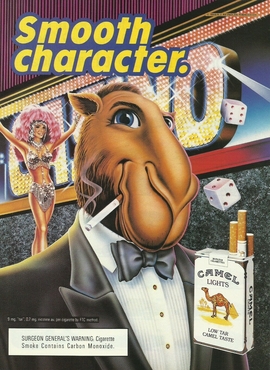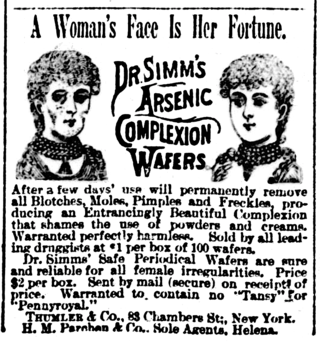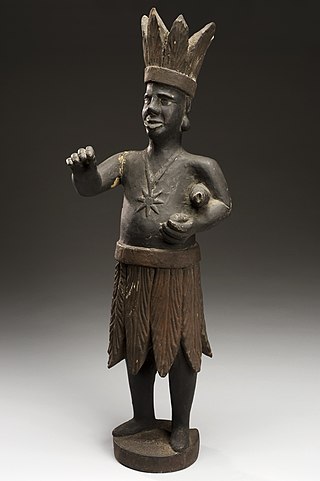Related Research Articles

Advertising is the practice and techniques employed to bring attention to a product or service. Advertising aims to put a product or service in the spotlight in hopes of drawing it attention from consumers. It is typically used to promote a specific good or service, but there are wide range of uses, the most common being the commercial advertisement.
Advertising slogans are short phrases used in advertising campaigns to generate publicity and unify a company's marketing strategy. The phrases may be used to attract attention to a distinctive product feature or reinforce a company's brand.

Sex appeal in advertising is a common tactic employed to promote products and services. Research indicates that sexually appealing content, including imagery, is often used to shape or alter the consumer's perception of a brand, even if it is not directly related to the product or service being advertised. This approach, known as "sex sells," has become more prevalent among companies, leading to controversies surrounding the use of sexual campaigns in advertising.

Joe Camel was an advertising mascot used by the R. J. Reynolds Tobacco Company (RJR) for their cigarette brand Camel. The character was created in 1974 for a French advertising campaign, and was redesigned for the American market in 1988. He appeared in magazine advertisements, clothing, and billboards among other print media and merchandise.

False advertising is the act of publishing, transmitting, or otherwise publicly circulating an advertisement containing a false claim, or statement, made intentionally to promote the sale of property, goods, or services. A false advertisement can be classified as deceptive if the advertiser deliberately misleads the consumer, rather than making an unintentional mistake. A number of governments use regulations to limit false advertising.

World No Tobacco Day (WNTD) is observed around the world every year on 31 May. The annual observance informs the public on the dangers of using tobacco, the business practices of tobacco companies, what the World Health Organization (WHO) is doing to fight against the use of tobacco, and what people around the world can do to claim their right to health and healthy living and to protect future generations.

Nicotine marketing is the marketing of nicotine-containing products or use. Traditionally, the tobacco industry markets cigarette smoking, but it is increasingly marketing other products, such as electronic cigarettes and heated tobacco products. Products are marketed through social media, stealth marketing, mass media, and sponsorship. Expenditures on nicotine marketing are in the tens of billions a year; in the US alone, spending was over US$1 million per hour in 2016; in 2003, per-capita marketing spending was $290 per adult smoker, or $45 per inhabitant. Nicotine marketing is increasingly regulated; some forms of nicotine advertising are banned in many countries. The World Health Organization recommends a complete tobacco advertising ban.

Alcohol advertising is the promotion of alcoholic beverages by alcohol producers through a variety of media. Along with nicotine advertising, alcohol advertising is one of the most highly regulated forms of marketing. Some or all forms of alcohol advertising are banned in some countries. There have been some important studies about alcohol advertising published, such as J.P. Nelson's in 2000.
Marketing ethics is an area of applied ethics which deals with the moral principles behind the operation and regulation of marketing. Some areas of marketing ethics overlap with media and public relations ethics.

Tobacco politics refers to the politics surrounding the use and distribution of tobacco.

Tobacco smoking has serious negative effects on the body. A wide variety of diseases and medical phenomena affect the sexes differently, and the same holds true for the effects of tobacco. Since the proliferation of tobacco, many cultures have viewed smoking as a masculine vice, and as such the majority of research into the specific differences between men and women with regards to the effects of tobacco have only been studied in-depth in recent years.

Cigarette smoking for weight loss is a weight control method whereby one consumes tobacco, often in the form of cigarettes, to decrease one's appetite. The practice dates to early knowledge of nicotine as an appetite suppressant.
The National Women’s Media Centre is a defunct Australian women’s organisation dedicated to the development of a media ethic within Australia which assumes the equality of women and men in all aspects of its operations.

The history of advertising can be traced to ancient civilizations. It became a major force in capitalist economies in the mid-19th century, based primarily on newspapers and magazines. In the 20th century, advertising grew rapidly with new technologies such as direct mail, radio, television, the internet and mobile devices.

The cosmetic industry describes the industry that manufactures and distributes cosmetic products. These include colour cosmetics, like foundation and mascara, skincare such as moisturisers and cleansers, haircare such as shampoos, conditioners and hair colours, and toiletries such as bubble bath and soap. The manufacturing industry is dominated by a small number of multinational corporations that originated in the early 20th century, but the distribution and sale of cosmetics is spread among a wide range of different businesses. Cosmetics must be safe when customers use them in accordance with the label's instructions or in the conventional or expected manner. One measure a producer may take to guarantee the safety of a cosmetic product is product testing. FDA occasionally does testing as part of its research program or when looking into potential safety issues with a product. Both the cosmetics business and consumers can benefit from the FDA's resources on product testing.
"Tobacco" is a segment of the HBO news satire television series Last Week Tonight with John Oliver about the tobacco industry. It first aired on February 15, 2015, as part of the second episode of the series' second season. During the eighteen-minute segment, comedian John Oliver discusses tobacco industry trends and practices.
The advertising industry is the global industry of public relations and marketing companies, media services, and advertising agencies. Several large advertising agencies, including WPP plc, Omnicom, Publicis Groupe, Interpublic and Dentsu, are among the industry's largest. It is a global, multibillion-dollar business that connects manufacturers and consumers. The industry ranges from nonprofit organizations to Fortune 500 companies.

The history of nicotine marketing stretches back centuries. Nicotine marketing has continually developed new techniques in response to historical circumstances, societal and technological change, and regulation. Counter marketing has also changed, in both message and commonness, over the decades, often in response to pro-nicotine marketing.
Electronic cigarettes are marketed to smoking and non-smoking men, women, and children as being safer than cigarettes. In the 2010s, large tobacco businesses accelerated their marketing spending on vape products, similar to the strategies traditional cigarette companies used in the 1950s and 1960s.
An annoyance factor, in advertising and brand management, is a variable used to measure consumers' perception level of annoyance in an ad, then analyzed to help evaluate the ad's effectiveness. The variable can be observed or inferred and is a type that might be used in factor analyses. An annoyance effect is a reference to the impact or result of an annoying stimulus, which can be a strategic aspect of an advertisement intended to help a message stick in the minds of consumers. References to annoyance effects have been referred to as annoyancedynamics. While the words "factor" and "effect", as used in the behavioral sciences, have different meanings, in casual vernacular, they have been used interchangeably as synonymous. A more general or umbrella term would simply be advertising annoyance.
References
- ↑ THE MEDIA BUSINESS: Advertising; International Trade Group Reorganizes, The New York Times, Randall Rothenberga, (APRIL 9, 1990)
- 1 2 "IAA launches the case for advertising - International Advertising Association". Adforum.com. 2014-02-20. Retrieved 2017-07-11.
- 1 2 3 4 5 6 7 John Philip Jones (2000). Advertising Organizations and Publications: A Resource Guide. SAGE Publications. pp. 159–167. ISBN 978-1-4522-2186-1.
- 1 2 3 4 Hong Cheng (2014). The Handbook of International Advertising Research. Wiley. pp. 10–12. ISBN 978-1-118-37845-8.
- ↑ International Advertising Association - Our History, International Advertising Association (2014)
- 1 2 Miracle, Gordon E. (1984). "An Assessment of Progress in Research on International Advertising". Current Issues and Research in Advertising. 7 (2): 135–166. doi:10.1080/01633392.1984.10505367.
- ↑ "'The Case for Advertising' - IAA pitches ads as vital public service in global campaign". Marketing Magazine. 2014-02-23.
- ↑ Boddewyn, Jean J. (1991). "Controlling Sex and Decency in Advertising around the World". Journal of Advertising. 20 (4): 25–35. doi:10.1080/00913367.1991.10673352.
- ↑ Charles S. Mack (1991). The Executive's Handbook of Trade and Business Associations. Greenwood. pp. 191–194. ISBN 978-0-89930-531-8.
- ↑ Barbara Mueller (2011). Dynamics of International Advertising: Theoretical and Practical Perspectives. Peter Lang. pp. 314–316. ISBN 978-1-4331-0384-1.
- ↑ Mack, Charles (1991). The executive's handbook of trade and business associations : how they work, and how to make them work effectively for you. New York: Quorum Books. p. 192. ISBN 978-0-89930-531-8.
- ↑ "IAA GLOBAL". www.iaaglobal.org. Archived from the original on 2013-04-17.
- ↑ "The Case for Advertising". Welcome to IAA Global. Retrieved 2017-07-11.
- ↑ Neuman, Mark; Bitton, Asaf; Glantz, Stanton (2002). "Tobacco industry strategies for influencing European Community tobacco advertising legislation". The Lancet. 359 (9314). Elsevier BV: 1323–1330. doi:10.1016/s0140-6736(02)08275-2. PMID 11965294. S2CID 30638673.